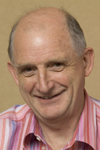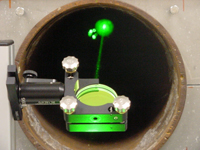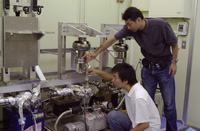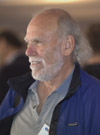 |
|
|
 |
| From LEP to LHC, David Miller Sees Growing Support for ILC
“The majority of LHC physicists would like to see the ILC”, David Miller, University College London.
Professor David Miller from University College London retired as chair of
the World Wide Study of Physics and Detectors for the ILC at the end of
the Snowmass Workshop. He first became interested in the concept of a
Linear Collider in 1990 while he was working on LEP. He liked the fact
that physics was so much simpler at an e+ e- collider

David Miller
|
but he realized that
some important physics questions would not be answered at LEP and thus a
more powerful machine would be needed. Although at the beginning, only a
small minority supported the idea of a linear collider Miller is
pleased to see that the support is now strong enough to give a large and
healthy community.
Signatures on the
consensus document,
which he
helped to organise, suggest that a majority of LHC physicists would like
to see the ILC as well, and he believes that the HERA people and the beauty
factory people would
like to follow on with the ILC. Having 4 detector concepts for 2
interaction points does not worry him. Once the international laboratory
supporting the ILC has been been set up in 3 or 4 years, collaborations
will form drawing on the present concepts. As Miller is stepping down as
chair of the World Wide Study he hopes to have time to work on
spectrometry and on gamma-gamma physics. Studies on gamma-gamma are urgent
to establish its credibility as an option for the ILC.
--Nicolas Delerue
|
 |
|
|
 |
Upcoming meetings, conferences, workshops
ILC Industrial Meeting
Fermilab, USA, 21-22 September, 2005
SMTF Collaboration Meeting
Fermilab, USA, 5-7 October 2005
Nanobeams 2005
Kyoto, Japan, 17-21 October 2005
ECFA ILC Workshop
Vienna, Austria, 14-17 November 2005
TESLA Technology Collaboration Meeting and GDE Meeting
Frascati, Italy, 5-10 December 2005
2006 LCWS 2006
Bangalore, India, 9-15 March 2006
|
Beam Diagnostics

An access pipe in the laser-wire project. (Image courtesy of EUROTeV)
more information
|
|
 |
 |
|
|
 |
51 MV/m Achieved with Electro-polished Re-entrant Shape Cavity

Members of the high-gradient cavity team at KEK who recorded the 51 MV/m gradient on 6 September. |
The high gradient superconducting cavity is one of the most vital
components for the ILC. There were heated discussions
at the Snowmass 2005 workshop as to which cavity shape should be adopted
for the ILC baseline and how to
attain high-gradients in a reproducible way. While the TESLA type
cavity has a proven maximum gradient up to 40-41MV/m, new contender
schemes have been also vigorously pursued because they are likely
to allow the physicists to push toward a higher gradient.
A popular conjecture among the experts is that a maxium of approximately 51MV/m
should be attainable with a suitably shaped cavity, as limited by
the maximum surface current that the niobium material can sustain
in its superconducting state. In so doing, the use of the
electro-polishing technique, pioneered by the superconducting
cavity group at KEK, is considered to be a critical surface
treatment process to apply in cavity preparation.
Members of the high-gradient cavity team (WG5) at KEK, led
by Professor Kenji Saito, successfully recorded the long awaited
51 MV/m gradient at the Q0-value of 5.88e+9 on 6 September.
The test was performed on a single-cell "re-entrant"-type cavity
which has been designed, fabricated and post-purified by
Professor H.Padamsee's group at Cornell University. The cavities were
brought to Japan for surface treatments with the electro-polishing technique
and for subsequent tests at KEK.
read more
--Youhei Morita

Members of the high-gradient cavity team at KEK. |
|
 |
|
|
 |
From FYI: AIP Bulletin of Science Policy News,
14 September 2005
Unsettled Outlook for FY 2006 R&D Funding
With the start of the new fiscal year less than three weeks away, Congress and the Bush Administration have not settled on a strategy to fund R&D programs in the coming year. While the new chairmen of the House and Senate Appropriations Committees have expressed a desire for "regular order" by passing each of the appropriations bills separately, time is running out. One alternative calls for program funding to be continued at current levels, and in some instances, cut.
Read more
From CNRS,
8 September 2005
Supratech : le CNRS et le CEA créent une plate-forme de recherche
technologique régionale sur les cavités accélératrices supraconductrices
Summary: Future particle accelerators will use supraconducting accelerating
cavities to produce high intensity electron or proton beams. Several
French labs have decided to team up together to create "Supratech", a
collaboration aimed at building up and sharing the infrastructures
required for supraconducting cavities R&D.
Read more in French
|
|
 |
 |
|
|
 |
Director's Corner
Snowmass is now behind us. We are now ready to begin to assess the outcomes
from that successful workshop and to move on to our challenging next goal

Barry Barish
|
for this fall — to create a baseline configuration and alternatives
for the ILC. These will be documented in what we are calling a baseline
configuration document (BCD) that will become the basis of the design and
costing effort next year, as well as for developing the supporting R&D program.
There are many difficult and important decisions we must make in order for
us to create a solid baseline. The guiding principle that I have given to
the GDE in making these decisions is for us to make as forward looking
choices as we can, consistent with attaining our the performance goals,
and being understood well enough for us to do a conceptual design and reliable
costing by the end of 2006.
To begin work on this task of defining the baseline configuration, we have
assembled Snowmass summary information from the various working and global
groups, as well as for the "Himel List" of 40+ decision items that are needed
to develop our baseline configuration document (BCD). These have been posted
and are available in a new section of our web pages containing summaries of
the conclusions and recommendations from Snowmass. We will continually update
this information with both missing information and new inputs. These new
BCD web pages can be found online.
Read more
--Barry Barish
Director's Corner Archive
|
 |
|
|
 |
ILC Jobs - Position opening at LAL Orsay
A 3-year high level postdoctoral position is opened at the Laboratoire
de l’Accélérateur Linéaire d’Orsay (LAL), near Paris, to work on the
ILC-GDE project. The candidate should have at least 5 years of post
doctoral experience and have already demonstrated outstanding
skills and confirmed leadership capability.
Read more and view other ILC job openings
ILC Industrial Forum, September 21-22
The ILC Industrial Forum, hosted by the Linear Collider
Forum of America, will be at Fermilab on September 21 and 22.
An agenda is now available online.
Interested scientists and industries are welcome to attend
the forum free of charge. All industries should register with
Ken Olsen,
President of the LCFOA.
more information
ILC Related Preprints
hep-ph/0509070 : Signatures of anomalous Higgs interactions at a linear collider, 7 September 2005
hep-ph/0509135 : The Role of the ILC in the Study of Cosmic Dark Matter, 13 September 2005
If you recently released a preprint related to the ILC,
let us know!
|
|

